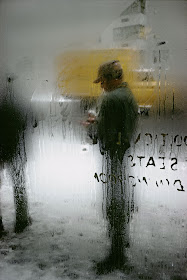

And his lack of ego shows the soul of the true artist. “My photographs are meant to tickle your left ear.” He was a singular talent. “A window covered with raindrops interests me more than a photograph of a famous person,” Leiter says in the documentary. He just wanted to create the work he wanted to create, be it in early morning paintings, or when out and about in his East Village neighborhood. But Leiter didn’t care about being famous. He was never as famous as his contemporaries, and looking at his work you cannot understand why that is so. Leiter’s work has more to do with that, then in creating a world that everyone can agree upon. “The real world has more to do with what is hidden,” he said. But through the work of Saul Leiter we can see that, “a state of pleasant confusion can be satisfying.”

It allows us to stick with a point of view. We want things to be black and white because we delude ourselves into thinking that it gives us clarity, and makes decisions easy. ©Saul Leiter, Courtesy Howard Greenberg Galleryīut to look at his wonderful work is to be blown away by the importance of it in the way it shows us the world as the blurry, sometimes gorgeous yet indistinct place it really is. This entry was posted in Don Schwartz Spotlight on Documentaries by Don Schwartz. Saul Leiter passed away on November 26, 2013, at his home in New York. 13 Lessons in Life with Saul Leiter - Personal statement by the photographer, Saul LEITERI believe there is such a thing.

I consider those additional interviews to be part of the movie. I recommend viewers see both the film and the additional interviews included in the Zeitgeist Films DVD.

Perhaps he has a control issue because whatever he thinks and feels about his work and those who regard it, there are Leiter collections in at least 14 museums throughout the United States and Europe.Īnd, of course, there is “In No Great Hurry” which introduces a prolific, passionate artist who has made an immeasurable contribution to the art of photography.ĭirector Tomas Leach has painted an affectionate, touching portrait of the artist as an old man. Leiter is clearly ambivalent – if not confused – about his worth, success and stature in the art world. Wearing baggy clothes, and laughing frequently, the legendary fine art photographer indulges his interlocutor with thoughts and feelings of himself, photography, people, and his lost love, Soames Bantry, who beat him to the punch. Nearing the end of his life, in his late 80s, Saul Leiter is gracefully suffering a man with a video camera following him around his home and in the streets, asking annoying questions.


 0 kommentar(er)
0 kommentar(er)
